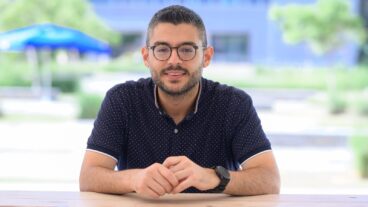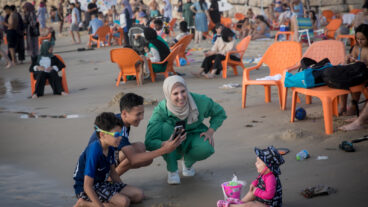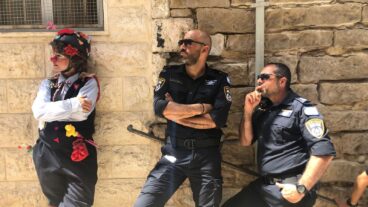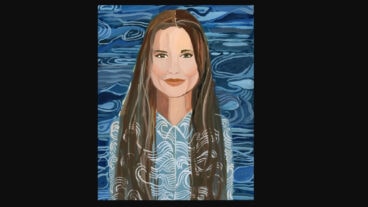For Dr. Eyal Gur, small things bring great rewards. Really small things, because Gur is a microsurgeon, operating at the level of blood vessels (1mm wide), which enables him to transfer tissue from one part of the body to another, and to reattach severed parts.
And he does it very well. So well that Newsweek magazine last year named Gur, head of the Microsurgery Unit at the Sourasky Medical Center in Tel Aviv, as one of the top 10 microsurgeons in the world.
Sourasky is one of the leading centers for treatment of patients suffering paralysis of the face as a result of neurological disorders, tumors, trauma or viral infection, which often leave the corners of the mouth frozen. Gur’s expertise is facial reanimation: a procedure that allows those who have suffered facial paralysis to regain movement.
The Newsweek description of his work gives an idea of the scope of his abilities. “As a surgeon, Gur navigates some of the toughest of surgical terrain – the human face has more nerve endings and muscles than any other animal’s. First, he transplants a sensory nerve from the patient’s calf to the non-paralyzed side of the face, connecting it like an extension cord to an active motor nerve. He waits, typically for nine months, while the new nerve grows along a conduit and reaches the paralyzed side of the face.”
Sitting in his Sourasky office, Gur displays a picture of nine-year-old Yoan, who was born with facial paralysis on one side of his face. In his ‘before’ picture, Yoan smiles on one side of his face, while the other side remains immobile and expressionless.
“There’s no happiness in that smile. I see misery and frustration,” Gur told ISRAEL21c. “A smile, if you look in Webster’s Dictionary, is not just motion obliquely across the face. It will say: ‘simultaneous with sparkle in the eye.’ It’s not just, you know, a mechanical thing. It moves, but needs happiness.”
Pointing to Yoan, he adds, “You see really sad eyes here.”
When Gur and his colleagues operated on Yoan, they began by ‘harvesting’ a small nerve from his leg, leaving only a negligible spot of numbness. When a nerve is removed it becomes unviable, but its casing of fibers – called a ‘myelin sheath’ – remains intact. This was implanted into the paralyzed side of Yoan’s face and threaded through to the functioning side.
The functioning side of the face has two main branches that create a smile: a major branch and a minor branch.
“The minor branch can be sacrificed to the procedure, since the major one backs up the motion. That’s the quality of the facial nerves, a lot of double connections, crisscrossing of fibers: back-ups,” Gur explains.
Gur and his colleagues directed the minor branch nerve to grow across the upper lip to the paralyzed side of the face, through the tunnel of the nerve taken from the leg.
“The nerve serves as a conduit: a tunnel that is very specific for nerve growth. Nerves grow through myelin sheathes at 1mm a day. In nine months, when I will tap on the cheek, the patient will feel some tingling,” he said.
The team then harvested a small muscle from the inner thigh, along with its artery, vein, and its motor nerve. The leg suffers no loss of function, since there are three other stronger muscles that perform the same action.
“We transfer the muscle to the paralyzed face, and through the same set of scars we connect the muscle, align it in the direction of the needed smile, connect the artery to the facial artery, the vein to the facial vein, and connect the nerve branch to the end of the nerve transplanted nine months before,” Gur says.
“It takes four to six months for the nerve that had reached that point to grow into the nerve that had grown into muscle. And once it does, a smile on the normal side sends an electrical stimulus to the muscles on the other side to smile. This is high tech, right?” Gur asks with pleasure.
In his ‘after’ picture, Yoan’s smile stretches across his face. “It looks so nice that I’m very proud of it,” Gur boasts. “When a kid or adult comes back, and for the first time in their lives they smile, it is a truly emotional time.”
He adds: “We operate on two patients a week. I suspect that’s because we’re the only center in the Middle East that performs this procedure.”
That dearth of expertise in microsurgery was the impetus for Gur to focus on that form of surgery.
“When I was a resident here, there was only one microsurgeon in the country: the field was very small. But getting to my sixth year of residency, I realized that only in microsurgery do we have the true solutions. We had great solutions for all sorts of situations in plastic surgery, but were disabled because we had no way to take tissues from one part of the body and move them. I asked the head of the department to send me to specialize in that field.”
Gur studied microsurgery in Toronto in 1996, and when he returned to Israel, he began to operate on patients – at the beginning only about four a year.
“Today we do over 120 cases a year, in a way that brings better function and better cosmetics to those patients – with less hospital stay, and less suffering and pain. So there’s an amazing role for that field,” he said.
Gur’s microsurgery center receives patients from Europe and the US, as well, and he’s frequently invited to speak for the United States Society of Reconstructive Microsurgery.
“We run a place that’s pretty much like the large microsurgery centers in the States, which makes me very proud of it: that is my reference point,” he said.
Because of an injury that Gur sustained in the first Lebanon War, he has undergone a below-knee amputation. Although he describes himself as functioning excellently, Gur says: “Many times in my life, and especially after becoming a microsurgeon, I’ve asked myself: could they have salvaged my limb? There was no microsurgery in those days in the country, so probably they could not have. And I do not ask that with any pain or any frustration: it’s not an emotionally intense question – it is more a question of interest. Like, if I was the doctor then, could I do it?
“One day I was asked to give a second opinion in the Rabin Medical Center about whether they should amputate a young guy’s limb or if there was an option to salvage. I remember myself walking up the stairs and realizing this was the floor where my leg was amputated. And I’m going to come there, close the circle, and give advice about the same issue: to amputate or not. This was a very strong moment. The head nurse was still the same – 1982 was my injury, and this was 20 years later.”
While the past is still present in his mind, Gur is clearly looking to the future regarding the next steps in microsurgery.
Currently, patients who require tissue transplants have two options: to receive parts from a brain-dead body, or to receive an engineered tissue – that is, one created wholly in a lab. Both of these procedures still involve a tremendous amount of risk; but current research may soon make these procedures safer and more common.
“We’ve decided to establish an applied microsurgery institute,” says Gur. “If one day we have a bank of tissues or organs that can be replaced in the human body, it would be an amazing solution for a lot of situations. At the end point, microsurgery will play a significant role in applying those techniques to the human body.
“Once an ear and blood vessels created in the lab can go in, someone will have to connect them to the human body. So I see myself playing a significant role in those two fields, and at the end point, may illuminate some of the major obstacles of human medicine today.”












